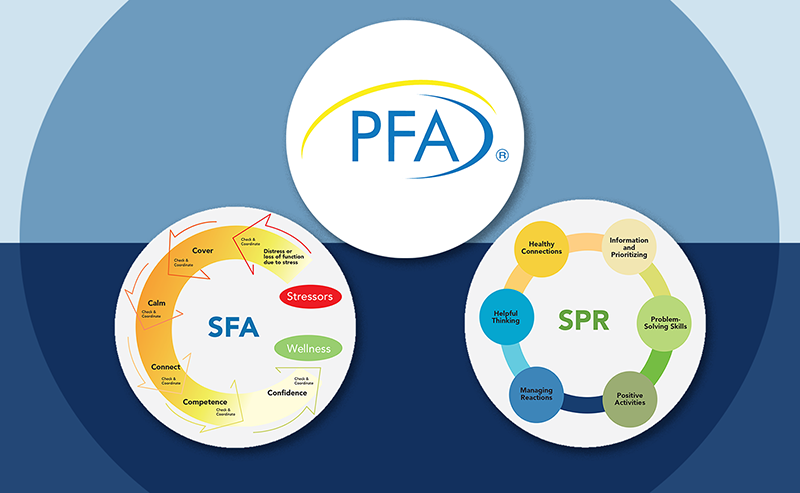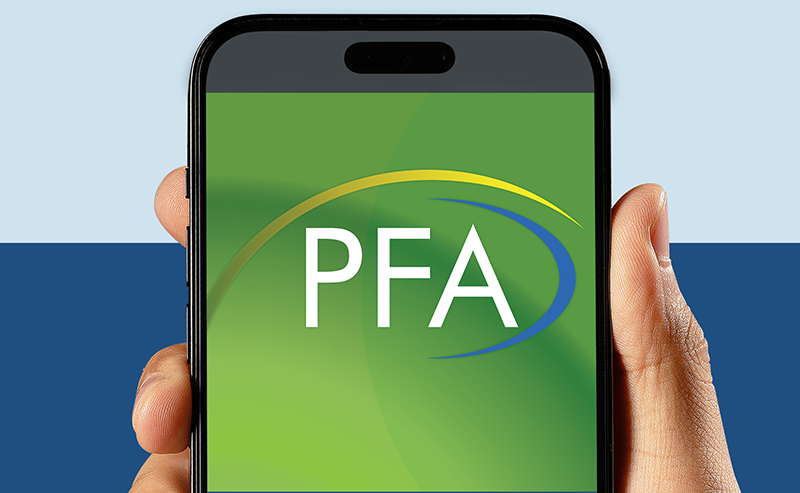PTSD: National Center for PTSD
Early Interventions Following Disaster Events
Early Interventions Following Disaster Events
Disaster events can be natural or human-caused disasters, mass violence, or public health emergencies like disease outbreaks, chemical spills, or radiation emergencies. In the immediate aftermath of these events, most affected individuals will experience some stress reactions. The intensity of their reactions is dependent upon risk and resilience factors including proximity to the event, the severity of initial reactions to it, and several demographic characteristics.
Organized psychosocial responses during this early stage are usually built into a broader public health response on the part of disaster response agencies. The goal is to maximize the natural resilience of affected individuals and communities and improve their coping abilities as a means to help prevent the development of mental health problems such as PTSD, depression, anxiety, and alcohol abuse. The majority of people are likely to respond well to this kind of support and provision of resources and will not require formal mental health treatment.
In This Article
Immediate Actions for Disaster-Affected Individuals
Support delivered within the first month following any type of traumatic event has not been well-researched. This is particularly true following disasters (e.g., 1-5). The few prospective and longitudinal studies that have been conducted suggest that a focus on reducing ongoing adversity, offering practical assistance, and bolstering social support may help mitigate the long-term consequences of potentially traumatic events (e.g., 6). International expert consensus guidance generally concurs with this recommendation, and suggests a multi-disciplinary stepped care approach, employing a variety of psychosocial strategies (i.e., 7-8).
According to these consensus statements, offering practical resources, providing safety and comfort, facilitating social connections, and stabilizing intense emotions are the most important actions to help foster natural resilience and recovery. Experts have identified five evidence-informed elements related to better early- and mid-term recovery after disasters (9). These elements provide a framework for how to work with all those affected by disasters and mass violence:
- Promoting a sense of psychological safety.
This includes actions such as bringing people to a safe place, getting survivors who are overwhelmed to focus on their present surroundings, and providing for basic needs and comfort (e.g., food, shelter, clothing, sleep). It could also include protecting individuals' personal space to the extent possible, addressing immediate physical health problems or injuries, and providing accurate information about recovery efforts and any ongoing threats. - Promoting calming.
Promotion of calming includes measures to reduce stress reactions that might interfere with needs like sleep, eating, and decision making. This can be accomplished by offering emotional support, helping people solve immediate problems, and giving information about relief efforts. Affected individuals can be taught breathing methods and other calming actions that reduce tension, anxiety, or despondency. If necessary, they can be provided with appropriate medications. Creating opportunities to grieve through memorials or other means can also be a way to promote calming. - Promoting a sense of self- and community efficacy.
After disaster or mass violence, people's belief in their ability to manage distressing events can be fostered by a number of means. Providing them with resources that can be used to help reverse the loss cycle, reminding them of their efficacy, and engaging in simple problem solving to help them address challenges caused by the event are all helpful measures. Responders can offer consultation and training to local providers and community leaders to help them more effectively implement community-based interventions. It is also important to support those providers who may be overwhelmed or who were themselves affected by the disaster. - Promoting connectedness.
This can be done by helping affected individuals identify and link with loved ones, friends, coworkers, and mentors. Responders and relief workers can also provide a sense of connection by helping affected individuals in proximity to one another at shelters become more connected, as well as by offering unobtrusive "ordinary" social contact, such as small talk about current events, silent companionship, and the judicious use of humor. - Instilling hope.
Identifying, amplifying, and concentrating on building strengths, as well as supporting rebuilding of local activities or communities all help to create a sense of hope among survivors. These measures allow individuals to resume their daily activities and prevent ongoing resource loss cycles.
Psychological First Aid
Psychological First Aid (PFA) is a flexible, strengths-based approach to helping people affected by disaster and mass violence. It was designed for those with higher exposure to loss and trauma or who are experiencing distress. It differs from traditional mental health services in that it has a supportive and educational rather than therapeutic "mental health treatment" focus. PFA also attempts to be sensitive to timing and context, as well as the age, culture, and preferences of affected individuals.
The aim of PFA is to reduce distress, foster short- and long-term adaptive functioning, and link distressed or at-risk survivors with additional services. Implementation of PFA does not require licensed mental health providers and it can be provided by anyone with a minimum of training. PFA actions generally map onto the five elements of safety, calming, connectedness, self-efficacy, and hope, but offer a more explicit set of guidelines to enact these elements.
The few uncontrolled studies of PFA that have been conducted focus on the experience of trainees, providers, and recipients in the field (e.g., 10,11). PFA is generally well-received by consumers and providers. In one study, PFA recipients reported a heightened ability to be calm and to help themselves and others, a greater sense of emotional control, improved functioning, and strengthened family relationships (10). While PFA models have not yet been systematically studied in a controlled way (4,12,13), they have been promoted by many consensus efforts as the approach that is most appropriate and least likely to do harm following disasters (e.g., 7,8,14).
A number of PFA models have been developed (8,15-24). These models vary in how they operationalize their core actions. The Psychological First Aid Field Operations Guide jointly developed by the National Child Traumatic Stress Network and the National Center for PTSD includes eight core actions, meant to be used as needed, in an individualized, tailored way (15):
- Contact and engagement.
Providing PFA involves being a caring, supportive listener, as well as knowing how to initiate contacts or respond to contacts initiated by affected individuals in an unobtrusive, compassionate, and helpful manner. - Safety and comfort.
PFA often involves enhancing immediate and ongoing safety, attending to acute loss, helping unaccompanied children, and providing physical and emotional comfort. - Stabilization.
Stabilization includes simple ways to calm and orient emotionally-overwhelmed or distraught survivors who require immediate intervention to help them manage intense stress reactions This model of PFA suggests the following actions:- Establishing rapport
- Ensuring the person's safety
- Acknowledging and validating the person's experience
- Offering empathy and providing privacy and space for the person, to the extent possible
- Recruiting support from family or friends, if possible
- Offering medication if appropriate
- Psychiatrists can be integrated into the response to help care for those with pre-existing, severe or persistent mental health and substance abuse issues.
- Information gathering.
PFA providers often help disaster-affected individuals identify immediate needs and concerns. Knowledge of post-disaster risk factors such as the extent of loss experienced, availability of social support, prior alcohol or drug use, and prior trauma exposure can also help providers to better support disaster survivors and tailor PFA interventions. - Practical assistance.
Following disaster or mass violence, ongoing demands and reactions to the chaotic nature of the post-trauma environment may reduce people's usual capacity to solve problems. Therefore, PFA will often involve helping affected individuals to identify, prioritize, and break down immediate problems into small steps, so that they do not seem overwhelming. This allows them to more effectively address immediate needs and concerns. - Connection with social supports.
One of the primary tasks of PFA providers is to help disaster-affected individuals connect with primary supports, including family members, friends, others nearby, and community helping resources. By using natural supports and talking with friends, family, and coworkers, disaster-affected individuals will be more likely to have the opportunity to share practical advice and resources, feel less alone, feel supported and understood, or receive concrete help with problems. - Information on coping supports.
Spending more time with disaster-affected individuals allows PFA providers to help them manage their stress reactions and deal with problems more effectively. PFA providers can offer basic psychoeducation about common stress reactions as a way to help survivors understand that their feelings are to be expected, and are understandable under the circumstances, rather than "pathological." PFA providers can also help individuals identify and increase positive coping strategies while avoiding less adaptive coping actions. - Linkage with collaborative services.
PFA providers often link survivors with services they currently require, or may need in the future.
Conclusion
With the implementation of public health and more individualized Psychological First Aid efforts, most people who have experienced disaster or mass violence will find that their distress drops off in time without the need of more formal mental health treatment. The most strongly affected, along with those who have pre-existing exposure to trauma and loss or prior histories of mental health issues, may benefit from crisis counseling, fostering of adaptive skills, or more formal assessment and intervention.
For more information about intermediate and long-term interventions for those affected by disaster and mass violence events, see:
- Intermediate Treatment Interventions Following Disaster and Mass Violence
- Long-Term Treatment Interventions Following Disaster and Mass Violence
References
- Bryant, R. A. (2015). Early intervention after trauma. In U. Schnyder & M. Cloitre (Eds.) Evidence based treatments for trauma-related psychological disorders: A practical guide for clinicians (pp. 125-142). Switzerland: Springer International Publishing. doi:10.1007/978-3-319-07109-1_7
- Dieltjens, T., Moonens, I., Van Praet, K., De Buck, E., & Vandekerckhove, P. (2014). A systematic literature search on psychological first aid: Lack of evidence to develop guidelines. PloS one, 9, e114714. doi:10.1371/journal.pone.0114714
- Shultz, J. M., & Forbes, D. (2014). Psychological first aid: Rapid proliferation and the search for evidence. Disaster Health, 2, 3-12. doi:10.4161/dish.26006
- Shalev, A. Y., Ankri, Y., Israeli-Shalev, Y., Peleg, T., Adessky, R., & Freedman, S. (2012). Prevention of posttraumatic stress disorder by early treatment: Results from the Jerusalem Trauma Outreach and Prevention Study. Archives of General Psychiatry, 69, 166-176. doi:10.1001/archgenpsychiatry.2011.127
- O'donnell, M. L., Lau, W., Tipping, S., Holmes, A. C., Ellen, S., Judson, R., ... & Forbes, D. (2012). Stepped early psychological intervention for posttraumatic stress disorder, other anxiety disorders, and depression following serious injury. Journal of Traumatic Stress, 25, 125-133. doi:10.1002/jts.21677
- Galea, S., Ahern, J., Tracy, M., Hubbard, A., Cerda, M., Goldmann, E., & Vlahov, D. (2008). Longitudinal determinants of posttraumatic stress in a population-based cohort study. Epidemiology, 19, 47-54. doi:10.1097/EDE06013e318815c1dbf
- Bisson, J. I., Tavakoly, B., Witteveen, A. B., Ajdukovic, D., Jehel, L., Johansen, V. A., ...& Olff, M. (2010). TENTS guidelines: Development of post-disaster psychosocial care guidelines through a Delphi process. British Journal of Psychiatry, 196, 69-74. doi:10.1192/bjp.bp.109.066266
- Inter-Agency Standing Committee (IASC). (2007). IASC guidelines on mental health and psychosocial support in emergency settings [Online book].Retrieved from www.who.int/mental_health/emergencies/
guidelines_iasc_mental_health_psychosocial_june_2007.pdf. - Hobfoll, S.E., Watson, P., Bell, C.C., Bryant, R.A., Brymer, M.J., Friedman, M.J. et al. (2007). Five essential elements of immediate and mid-term mass trauma intervention: Empirical evidence. Psychiatry, 70, 283-315. doi:10.1521/psyc.2007.70.4.283
- Schafer, A., Snider, L., & Sammour, R. (2016). A reflective learning report about the implementation and impacts of Psychological First Aid (PFA) in Gaza. Disaster Health, 3, 1-10. doi:10.1080/21665044.2015.1110292
- Schafer, A., Snider, L., & van Ommeren, M. (2010). Psychological first aid pilot: Haiti emergency response. Intervention, 8, 245-254. doi:10.1097/wtf.0b013e32834134cb
- Fox, J. H., Burkle, F. M., Jr., Bass, J., Pia, F. A., Epstein, J. L., & Markenson, D. (2012). The effectiveness of psychological first aid as a disaster intervention tool: Research analysis of peer-reviewed literature from 1990-2010. Disaster Medicine and Public Health Preparedness, 6, 247-252. doi:10.1001/dmp.2012.39
- Bisson, J. I., & Lewis, C. (2009). Systematic review of Psychological First Aid. Geneva: World Health Organization.
- Bryant, R. A., & Litz, B. T. (2009). Mental health treatments in the wake of disaster. In Y. Neria, S. Galea, & F. Norris (Eds.) Mental health consequences of disasters (pp. 321-335). New York, NY: Cambridge University Press.
- Brymer, M., Jacobs, A., Layne, C., Pynoos, R., Ruzek, J., Steinberg, A., ... & Watson, P. (2006). Psychological First Aid Field Operations Guide, 2nd Edition. National Child Traumatic Stress Network & National Center for PTSD. Retrieved from www.nctsn.org and www.ptsd.va.gov.
- Australian Psychological Society & Australian Red Cross. (2013). Psychological First Aid: An Australian guide, 2nd Edition. Retrieved from https://www.redcross.org.au/getmedia/23276bd8-a627-48fe-87c2-5bc6b6b61eec/Psychological-First-Aid-An-Australian-Guide.pdf.aspx
- Center for the Study of Traumatic Stress. (2019) Psychological First Aid: How you can support well-being in disaster victims. Disaster Response Education and Training Project, Center for the Study of Traumatic Stress. Retrieved from https://www.cstsonline.org/assets/media/documents/CSTS_FS_psychological_first_aid.pdf
- Reference Centre for Psychosocial Support & International Federation of Red Cross and Red Crescent Societies. (2009). Psychosocial interventions - A handbook. Copenhagen, Denmark: International Federation Reference Centre for Psychosocial Support. Retrieved from http://pscentre.org/wp-content/uploads/2018/02/PSI-Handbook_EN_July10.pdf
- Reference Centre for Psychosocial Support & International Federation of Red Cross and Red Crescent Societies. (2009). Community-based psychosocial support (Participant's book and Trainers Book). Copenhagen, Denmark: International Federation Reference Centre for Psychosocial Support. Retrieved from http://pscentre.org/?post_type=resource
- Johns Hopkins & Red Cross Red Crescent. (2008). Public health guide in emergencies, 2nd Edition. Geneva, Switzerland: International Federation of Red Cross and Red Crescent Societies. Retrieved from https://reliefweb.int/sites/reliefweb.int/files/resources/Forward.pdf
- Substance Abuse and Mental Health Services Administration (SAMHSA). (2007). Psychological First Aid - A guide for emergency and disaster response workers. Washington, DC: U. S. Department of Health and Human Services.
- Substance Abuse and Mental Health Services Administration (SAMHSA). (2010). Psychological First Aid for first responders - Tips for emergency and disaster response workers. Washington, DC: U. S. Department of Health and Human Services. Retrieved from https://store.samhsa.gov/system/files/nmh05-0210.pdf
- World Health Organization, War Trauma Foundation & World Vision International. (2011). Psychological first aid: Guide for field workers. Geneva, Switzerland: WHO. Retrieved from https://www.who.int/mental_health/publications/guide_field_workers/en/
- NSW Health & University of Western Sydney. (2012). Psychological First Aid (PFA). In NSW Health Disaster Mental Health Manual 2012 (pp. 101-103). Sydney, Australia: Disaster Response & Resilience Research Group, University of Western Sydney. Retrieved from https://www.health.nsw.gov.au/emergency_preparedness/mental/Documents/disaster-mental-health-manual.pdf
You May Also Be Interested In


























